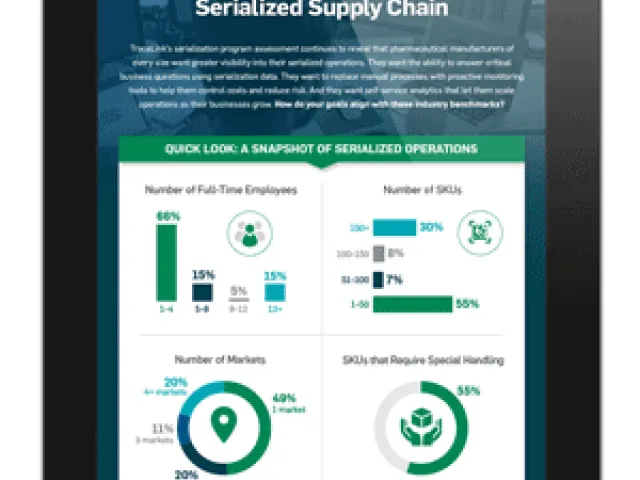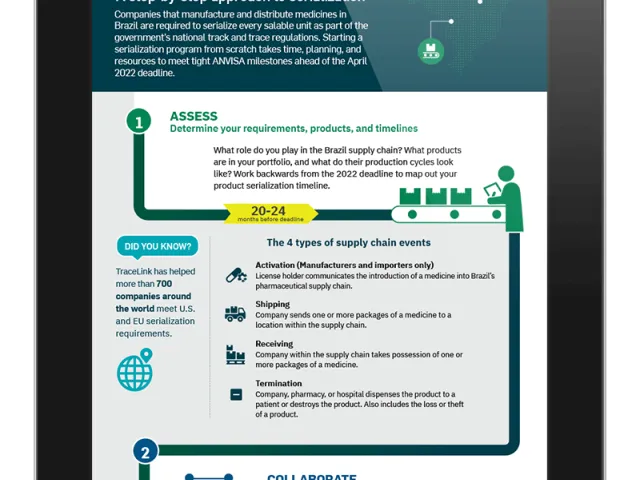Table of contents
When a mid-size U.S. manufacturer of generic medications acquired the U.S. generic arm of another global drug manufacturer, it prompted their global serialization team to reassess how they would collectively manage serialization and track and trace across the new enterprise. Up to that point, the parent company’s solution vendor, Axway, had been unable to meet many of their functional requirements and timelines, and the acquired company had been struggling with an SAP implementation from their previous owner.
Given these pre-existing concerns, and with the company now doubling in size, they agreed a new approach was needed to address the tens of millions of serial numbers they would be jointly commissioning annually. To avoid further delays and risks, the growing business switched entirely to TraceLink for full-stack serialization, including the TraceLink Edge Track solution for managing serialization in the distribution process.
Four critical shortcomings
There were several key factors that spurred the company to look for a new serialization solution provider:
• Massive infrastructure costs
Relying on an on-premises architecture meant that the company had to make a significant investment in hardware infrastructure in order to support their serial number volumes, and would only have to invest more to store the tens of millions of serial numbers they were adding as a result of their acquisition.
• Inability to scale for serialization performance
The relational database architecture of the parent company’s vendor was struggling to process lot-level transactions, in which a batch shipment of 10,000 units requires just four transactions. This led to concerns about their ability to manage serialization—the same batch requires 60,000 serialization transactions to be updated for every single unit. To keep up with processing, the manufacturer’s only option would have been to spend more to acquire bigger, more powerful hardware.
• Inefficient partner and packaging line connectivity
Creating point-to-point connections with each CMO was taking longer than expected, and the acquisition meant six additional CMOs were being added to the list. In addition, establishing connectivity to the company’s internal packaging lines was not successful and far behind schedule.
• Lack of committed vendor resources
The parent company’s vendor was unable to provide adequate resources to custom build new functionality for serial number provisioning changes without a several-month delay.
Decision driver: Scalability at lower overall cost
When the company decided to reassess their vendor options, they quickly ruled out SAP based on the acquired company’s experience where the AII/OER solution had problems processing serial numbers. A leading independent systems integrator serving as an advisor for merger-related IT strategy cautioned them against using the new ATTP platform as an unproven system.
The company ultimately chose TraceLink for its ability to address all of their needs, including:
• Lowest total cost of ownership
By using a native cloud-computing, network-tenant architecture, TraceLink addresses many of the unpredictable costs of serialization within an all-inclusive subscription model, eliminating separate line items and unpredictable costs. Regardless of project size, TraceLink consistently delivers lower TCO than any other single-tenant or on-premises alternative.
• Measurable performance and scalability gains
Implementing a solution that can manage the massive amounts of serialization data and transactions is critical to getting
This unique approach to speed, scalability, and efficiency allows TraceLink to add real-time processing power as needed for unrivaled benchmark results:
-
Provision 100K random serial numbers in 56 seconds.
-
Commission 100K serial numbers in under 1 minute.
-
Send 100K DSCSA-compliant messages in 50 seconds.
-
Total process, provision to reporting, of 5 minutes.
-
Read 150K serial numbers per second.
-
Write 10K serial numbers per second.
• Rapid CMO connectivity
The TraceLink network approach allows customers to integrate once, then interoperate with all 283,000+ supply chain businesses that are on the network, eliminating the need for point-to-point connections. When the company turned to TraceLink, they found that 70% of their CMO partners were already on the network, saving them valuable time. In addition, TraceLink has an entire team dedicated to working with customers’ partners, managing a lot of the implementation work so that companies don’t have to tackle it themselves.
The company in turn also serves as a CMO to multiple brand owners. In their CMO capacity, they were able to follow the same streamlined TraceLink onboarding approach.
• 24/7 support
TraceLink customers get the support and attention they need to complete serialization implementation. With more than 400 employees around the world—and global R&D and Services teams of over 100 people—TraceLink service reps are available 24/7 and provide support in 15 languages.
Outcome: A platform built for complex integration and successful onboarding
Switching to TraceLink has enabled the company to rapidly integrate partners and conduct massive transaction processing at
The TraceLink Life Sciences Cloud is the only purpose-built solution that digitizes the entire pharmaceutical supply chain to help drug manufacturers, distributors, hospitals, and pharmacies meet existing and emerging regulations around the globe. With nearly 400 pharmaceutical and contract manufacturing customers on its network—including more than 140 that are sharing live serialization data with partners today—TraceLink offers the only proven playbook for serialization-readiness. Contact us to learn more.









